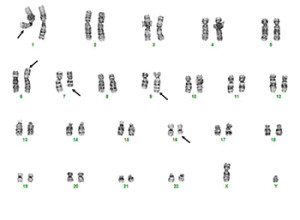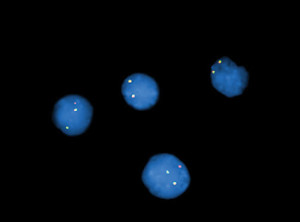
Fig. 4. Bone marrow chromosome analysis revealed a complex karyotype that included the t(6;7)(p25.3;q32.2) resulting in DUSP22 gene rearrangement in four of 20 metaphase cells.
ALK-negative anaplastic large cell lymphoma patients treated with the standard chemotherapy regimen, which includes cyclophosphamide, doxorubicin, vincristine, and prednisone (CHOP), shows variable results, with five-year overall survival rates ranging from 15 percent to 62 percent.<sup>5</sup> After induction chemotherapy, some patients receive a consolidative autologous transplantation in first complete remission, although it is difficult to determine which patients will respond to this regimen.5 The variability in overall survival rates and treatment responsiveness may be due to the genetic heterogeneity of the disease; therefore, additional studies are warranted to further examine who will benefit from more aggressive treatments.

Fig. 5. Interphase fluorescence in situ hybridization analysis using a DUSP22 break apart DNA probe confirmed DUSP22 gene rearrangement (abnormal hybridization pattern consisting of one red, one green, and one fusion signal).
After the patient received six cycles of CHOEP (cyclophosphamide, doxorubicin, vincristine, etoposide, and prednisone), a follow-up bone marrow study showed trilineage hematopoiesis without evidence of residual lymphoma. Concurrent cytogenetic analysis of the bone marrow revealed a normal male karyotype without evidence of the abnormal clone identified previously. The patient achieved first complete remission and received an autologous peripheral blood stem cell transplant. A follow-up PET scan 233 days status post-transplant showed no focal abnormal FDG activity that would suggest residual malignancy. At this time the patient has completed his chemotherapy regimen without recurrence of disease. We speculate that the patient will have a favorable outcome based on recent literature and the presence of the DUSP22 rearrangement. The clinical significance of additional chromosome abnormalities identified in this case with regard to prognosis is uncertain.
- Feldman A, Dogan A, Smith DI, et al. Discovery of recurrent t(6;7)(p25.3;q32.3) translocations in ALK-negative anaplastic large cell lymphomas by massively parallel genomic sequencing. Blood. 2011;117(3):915–919.
- King RL, Dao LN, McPhail ED, et al. Morphologic features of ALK-negative anaplastic large cell lymphomas with DUSP22 rearrangements. Am J Surg Pathol. 2016;40(1):36–43.
- Parrilla Castellar ER, Jaffe ES, Said JW, et al. ALK-negative anaplastic large cell lymphoma is a genetically heterogeneous disease with widely disparate clinical outcomes. Blood. 2014;124(9):1473–1480.
- Xing X, Flotte TJ, Law ME, et al. Expression of the chemokine receptor gene, CCR8, is associated with DUSP22 rearrangements in anaplastic large cell lymphoma. Appl Immunohistochem Mol Morphol. 2015;23(8):580–589.
- Hapgood G, Savage KJ. The biology and management of systemic anaplastic large cell lymphoma. Blood. 2015;126(1):17–25.
Dr. Haberichter is a pathology resident, Dr. Crisan is the medical director of molecular pathology, and Dr. Micale is the medical director of the clinical cytogenomics laboratory, Department of Pathology and Laboratory Medicine, Beaumont Health, Royal Oak, Mich.
 CAP TODAY Pathology/Laboratory Medicine/Laboratory Management
CAP TODAY Pathology/Laboratory Medicine/Laboratory Management
